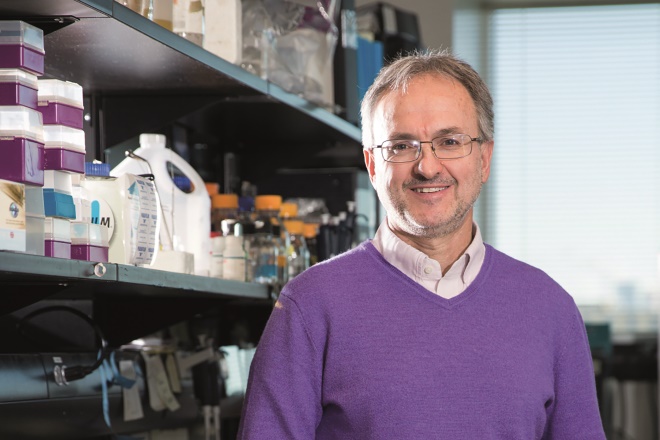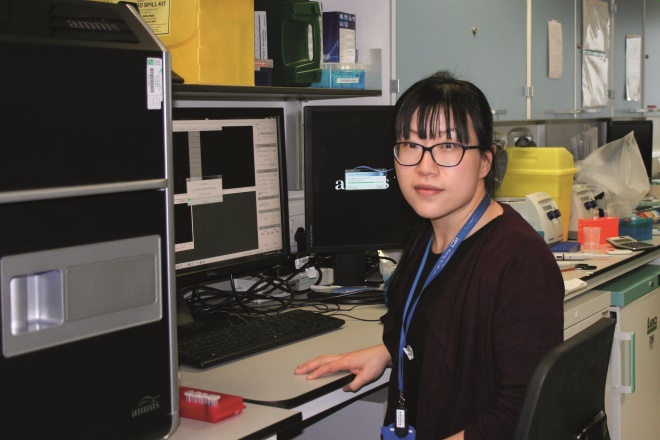
Donough O'Malley
In 1922, just a year after insulin was discovered and purified, it was used for the first time to treat type 1 diabetes mellitus (T1DM). The disease — in which immune system cells mistakenly attack and destroy the insulin-producing beta cells of the pancreas — was no longer a death sentence.
“But after nearly 100 years, while we’ve got fancier insulin and fancier delivery systems, that’s all we’ve got,” observes Colin Dayan, a leading diabetes researcher at the University of Cardiff, Wales.
For many other autoimmune diseases, such as rheumatoid arthritis (RA) and psoriasis, drugs that work by targeting components of the immune system are providing relief for millions of patients. There is not yet a licensed immunotherapy for T1DM — but that may soon change.
Barriers to development
There are several reasons why there are currently no immunotherapies for T1DM, says Dayan. Firstly, insulin has long been available, so there has not been a big push from clinicians for a new therapy. Patients must regularly check their blood sugar level and calculate the amount of insulin to inject but if they can manage this indefinitely, it is possible to lead a relatively normal life, says Dayan.
However, as noted by Karen Addington, chief executive of the Juvenile Diabetes Research Foundation (JDRF) in the UK, a 5-year-old child diagnosed with T1DM faces up to 19,000 injections and 50,000 finger pricks by the time they are 18 years old. About 80% of people with T1DM do not control their blood sugar levels well enough to avoid the increased risk of long-term complications such as heart disease and stroke. An immunotherapy would not be a ‘cure’ for T1DM, but it could be given by injection, perhaps every two months, making it dramatically easier for patients to manage their disease, and so improving their health in the long term.
A 5-year-old child diagnosed with T1DM faces up to 19,000 injections and 50,000 finger pricks by the time they are 18 years old
Another major reason for the absence of licensed immunotherapies is that clinicians have not been keen to refer patients with T1DM on to trials of this class of drug, says Dayan, who also heads the clinical engagement and training core of the T1DM UK Immunotherapy Consortium, an organisation set up in 2015 with funding from Diabetes UK and the JDRF to promote, develop and support immunotherapy research in T1DM. Partly, he says, this has been down to a lack of understanding among diabetes specialists that new-generation immunotherapies have fewer unpleasant — and potentially dangerous — side effects than older immune-suppressing drugs. “So now you move from a position where people have to come in for an [intravenous] infusion of a drug that makes you shiver and shake and feel unpleasant, to an injection given every two months — and it’s way easier than insulin,” he says.

Source: Courtesy of Colin Dayan
Colin Dayan, a leading diabetes researcher at the University of Cardiff, Wales, believes that the failure of three T1DM immunotherapies in phase III trials has deterred investment in the area
The third factor has been a relative lack of engagement from pharmaceutical companies, Dayan adds.
With a trial of new therapy for a disease like RA, if the joint pain goes away, the treatment can immediately be judged to be working. With psoriasis, it is also quick and straightforward to evaluate a new treatment. For T1DM, it takes much longer. The primary outcome measure is usually levels of C-peptide. For each molecule of insulin made in the pancreas, a molecule of C-peptide is also produced — so C-peptide levels indicate how much insulin the patient is still making. But it can take at least a year to establish whether an experimental treatment is preserving C-peptide — and so endogenous insulin — levels.
Yet another hurdle is that while a disease like multiple sclerosis can progress relatively slowly, loss of insulin production happens quite rapidly over one to five years. While some pancreatic beta cells are preserved even in long-term patients — though the percentage is debated — these preserved cells become inactive, and do not secrete insulin. T1DM trials generally require recently diagnosed patients who still have some functioning beta cells; therefore, the number of patients eligible for trials is relatively small.
Compared with a disease like RA, people living with T1DM worldwide represent a relatively small market, adds Jeffrey Bluestone, an immunologist and director of the Hormone Research Institute in the Diabetes Center at the University of California, San Francisco (UCSF).
The field has not been helped by the disappointing failure of three T1DM immunotherapies in phase III trials. For example, in 2011 London-based GlaxoSmithKline and Cambridge, Massachusetts-based Tolerx — which subsequently went out of business — reported that after one year of treatment, their apparently promising experimental T-cell immunotherapy had not preserved C-peptide levels in patients with recently diagnosed T1DM. These failures have deterred investment in the area, Dayan believes.
However, Pere Santamaria, chair of the Julia McFarlane Diabetes Research Centre at the University of Calgary, Canada, argues that these phase III trials did not produce results because there were insufficient pre-trial evaluations, for example, on the best dosages. “Not enough homework was done. I think a lot of people jumped the gun,” he says.

Source: Courtesy of Pere Santamaria
Pere Santamaria, chair of the Julia McFarlane Diabetes Research Centre at the University of Calgary, Canada, is working on a therapy that involves presenting peptides from proteins expressed in pancreatic beta cells to the immune system in a bid to stop the attack
Research into T1DM immunotherapies did not stall entirely as a result. In fact, five existing drugs have been found to be effective for T1DM, at least at a phase II trial level, notes Dayan, but none of these are being taken forward for licensing. This could be because the remaining patent life of the drugs is relatively short, or because the financial inducement to run phase III trials for T1DM is not strong, he adds.
But, importantly, next-generation immunotherapies (see Table 1) are also being developed and there are a number now being investigated and trialed for T1DM.
Next-generation immunotherapies
Novo Nordisk, based in Crawley, UK, is running a phase II trial with an anti-IL-21 (interleukin-21) drug that affects the activation of T cells. IL-21 is primarily secreted by CD4+ helper T cells. It escalates the cytotoxic activity of natural killer cells. If all goes well, Dayan predicts that it could end up becoming the first licensed T1DM immunotherapy “because it’s owned and developed by a big company that has the facilities to take it to the next stage”.
Other groups are focusing on various aspects of the immune system.
At UCSF, Bluestone and his colleagues are working on a treatment that involves boosting levels of circulating regulatory T cells (Tregs). These are cells that can regulate or suppress other cells in the immune system. Since they control the immune response to either foreign or self peptides, they have the potential to dampen down the immune attack on beta cells. A phase I trial, in which Tregs were isolated from blood taken from newly diagnosed patients, expanded in the laboratory and then infused back into the patients, showed that the therapy was well tolerated[1]
. New York-based company Caladrius Biosciences is now conducting a phase II trial of the treatment. While these are protective cells, it is worth noting that they are not specific for diabetes.
Bluestone is also involved in a phase I study of this Treg therapy plus IL-2, a cytokine that is available commercially as aldesleukin, and which is approved by the United States Food and Drug Administration to treat adults with metastatic melanoma and metastatic kidney cancer. “Others are pursuing IL-2 alone and we are hoping that the combination will be safe and effective,” Bluestone says. He is also working with the University of Florida to develop a trial to test Tregs derived from umbilical cord blood.
At the City of Hope hospital in California, immunologist Bart Roep is leading work on a treatment based on isolating monocytes from a patient’s blood and incubating them with vitamin D3, among other things. This causes the monocytes, as they differentiate into dendritic cells (i.e. cells that present antigens to T cells), to become ‘tolerogenic’. While dendritic cells can present antigens for attack, they can also promote T-cell tolerance to particular antigens, partly through effects on Tregs. If these tolerogenic dendritic cells are injected back into patients together with a beta cell peptide that has been identified as a target for T-cell attack in T1DM, the hope is that the attack will be quashed. So far, a phase I trial has been completed but the results are not yet available.

Source: Courtesy of Bart Roep
Bart Roep, immunologist at City of Hope hospital in California, United States, says it is possible that immunotherapies may also help patients who are several years into the disease by aiding recovery of beta cells
Roep has also worked on critical beta cell peptides implicated in T1DM with a group at Kings College, London. In August 2017, Yuk-Fun Liu, King’s College London, and her colleagues reported the results of a phase I study involving the direct injection of MonoPepT1DE, based on a peptide from a molecule produced by beta cells that is then turned into insulin[2]
.
“The immunotherapy uses an antigen linked to the immune attack in type 1 diabetes, but by presenting it at low dose without the presence of an adjuvant, it is thought to build tolerance by changing the immune response,” explains Liu. “This tolerance is felt to be linked to the induction of regulatory T cells, which can help control the immune attack on the pancreas and switch cytokine responses from inflammatory to suppressive.”
The immunotherapy uses an antigen linked to the immune attack in type 1 diabetes, but by presenting it at low dose without the presence of an adjuvant, it is thought to build tolerance by changing the immune response
For the phase I study, 21 people diagnosed with T1DM in the past 100 days received an injection of this ‘un-vaccine’ (as it seeks to reduce the immune response to the peptide, rather than stoke it) every few weeks for six months, and eight received a placebo. The drug was safe and well tolerated. And, after 12 months, there was less of a decline in C-peptide production in the treated group. “While this is encouraging, further confirmation will be needed in larger studies,” notes Liu.
Santamaria is also working on a therapy that involves presenting peptides from proteins expressed in pancreatic beta cells to the immune system in a bid to stop the attack. His drug candidate consists of nanoparticles coated with these peptides, which are bound to major histocompatibility complex molecules, cell surface proteins essential for the acquired immune system to recognise foreign molecules. Work in mice has found that T cells that recognise and bind with one of these peptides (and which would normally attack them) are reprogrammed into Tregs; these cells then expand massively, and spread throughout the body — including the pancreas — and suppress the attack on beta cells.
In a paper published in Nature in 2016, a team led by Santamaria reported that in mice genetically modified to biologically simulate T1DM in people, this treatment can stop the disease developing and also restore blood sugar levels to normal[3]
.
“Santamaria’s innovative discovery represents a remarkable advance in diabetes research,” says Jan Hux, chief science officer of the Canadian Diabetes Association, which helps to fund the research.
Santamaria’s innovative discovery represents a remarkable advance in diabetes research
The discovery in 2004 was serendipitous, Santamaria notes. It resulted from work aimed at improving real-time magnetic resonance imaging of inflammation in the pancreas. “But it turned out that it had these bizarre, unforeseen therapeutic effects. Then I had to go backwards to try to understand why it was a drug, and how it worked.”
In 2016, a company called Parvus Therapeutics, which Santamaria co-founded, signed a deal with Novartis to take it forward as a potential treatment for T1DM.
Target population
About half of people with T1DM are diagnosed as children, and diagnoses can come as early as six months of age.
The sooner immunotherapy could be given after diagnosis, the better. “Earlier intervention with any immunotherapy increases the chance that a greater proportion of beta cells can be protected,” notes Liu.
Earlier intervention with any immunotherapy increases the chance that a greater proportion of beta cells can be protected
Depending on what proportion of beta cells are left by the time a patient is diagnosed, some insulin may still be needed. Still, “being able to retain endogenous insulin production would lead to less reliance on insulin injections, making glucose variations easier to control and, importantly, protecting against future complications,” Liu says.

Source: MAG / The Pharmaceutical Journal
Yuk-Fun Liu, a researcher at King’s College London, says that being able to retain endogenous insulin production would lead to less reliance on insulin injections, making glucose variations easier to control and protecting against future complications
When children reach about five years, it is possible to predict who will go on to develop the disease. If screening was employed to identify potential patients, even before beta cell loss, this would need to be done at a population level, since 85% of new cases come from families without a history of T1DM.
It is possible, however, that immunotherapies may also help patients who are several years into the disease by aiding recovery of beta cells. Research suggesting that patients who have had T1DM for many years have only 15–20% of beta cells left is not necessarily reliable, Liu says, adding there is growing evidence that big variations exist between patients. The figure may be higher — even up to about 50%, says Roep.
Santamaria explains that there is a lot of dysfunction of the pancreatic beta cells in response to inflammation. “There is so much inflammation that they cease to produce insulin. So there is hope that maybe these [immunotherapy] treatments would also be applicable to these patients. But that is speculative.”
There are drugs used in type 2 diabetes that ease stress in the islets (beta cell groups) of the pancreas, such as glucagon-like peptide-1 analogs. Using them in conjunction with an immunotherapy may be a good route forward, Roep says.
Bluestone agrees that if inflammation in the pancreas can be reduced, it is possible that there will be more beta cell recovery. But beta cell replacement or preventive treatments are the ultimate goal, he remarked.
Beta cells can be replaced through transplantation, generally of islets of the pancreas. But patients must then take broadly immune-suppressing drugs, which increase vulnerability to infections and raise the risk of cancer. While islet transplantation is conducted on the NHS, the number of patients deemed suitable each year is small. The procedure tends to be reserved for people who need a kidney transplant because of poorly controlled diabetes and so will need to take immunosuppressant drugs in any case.
No single immunotherapy
Various immunotherapy approaches are being considered, but Bluestone does not believe there will be a single immunotherapy that works for T1DM. “If you look at cancer immunotherapy, it will take combination therapies that control different aspects of immunity and beta cell survival,” he says. “Depletion of effector cells, promotion or replacement of Tregs and recovery of beta cell function … various approaches need to be tested to address these various aspects.”
But what is really needed now is a single licensed drug, Dayan believes. That would encourage other companies to look at what they have got, consider whether it might work better or be safer for T1DM, or whether it might be a potential follow-on drug.
Bluestone agrees: “Once we have one approved immunotherapeutic drug, the field will take off, just like it did in cancer.”
| Strategy | Mechanism | Stage of development |
|---|---|---|
| Anti-IL-21 | Reduces activation of natural killer cells | Phase II |
| Regulatory T cells (Tregs) | Boosts levels of circulating regulatory T cells | Phase II |
| Tregs plus interleukin-2 | Boosts levels of circulating regulatory T cells | Phase I |
| Vitamin D3 | Promotes T-cell tolerance to particular antigens | Phase I |
| Critical beta cell peptides | Builds tolerance by changing the immune response | Phase I |
Reading this article counts towards your CPD
You can use the following forms to record your learning and action points from this article from Pharmaceutical Journal Publications.
Your CPD module results are stored against your account here at The Pharmaceutical Journal. You must be registered and logged into the site to do this. To review your module results, go to the ‘My Account’ tab and then ‘My CPD’.
Any training, learning or development activities that you undertake for CPD can also be recorded as evidence as part of your RPS Faculty practice-based portfolio when preparing for Faculty membership. To start your RPS Faculty journey today, access the portfolio and tools at www.rpharms.com/Faculty
If your learning was planned in advance, please click:
If your learning was spontaneous, please click:
References
[1] Bluestone JA, Buckner JH, Fitch M et al. Type 1 diabetes immunotherapy using polyclonal regulatory T cells. Sci Transl Med 2015;7:315ra189. doi: 10.1126/scitranslmed.aad4134
[2] Ali MA, Liu Y-F, Arif S et al. Metabolic and immune effects of immunotherapy with proinsulin peptide in human new-onset type 1 diabetes. Sci Transl Med 2017;9:eaaf7779. doi: 10.1126/scitranslmed.aaf7779
[3] Clemente-Casares X, Blanco J, Ambalavanan P et al. Expanding antigen-specific regulatory networks to treat autoimmunity. Nature 2016;530:434–440. doi: 10.1038/nature16962


